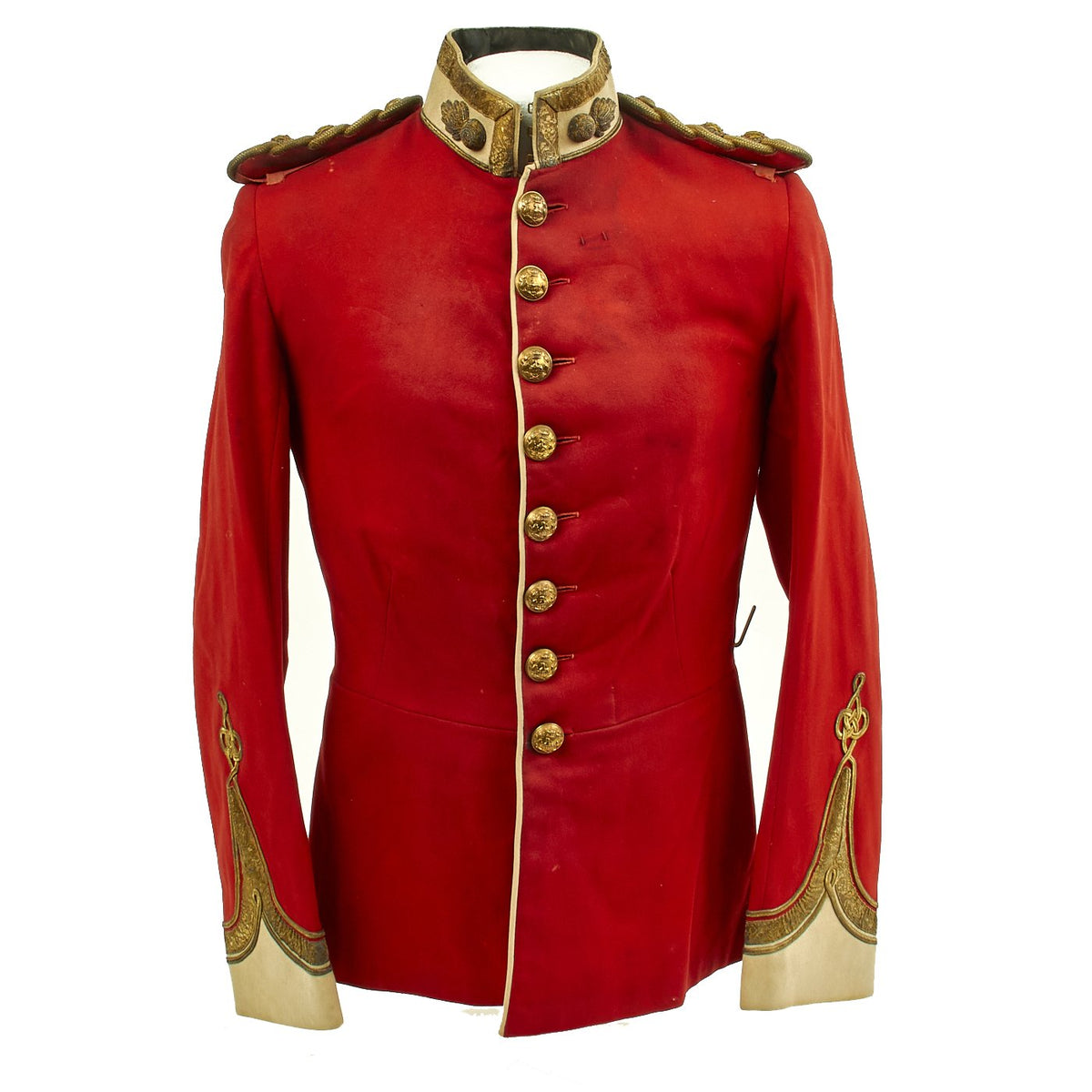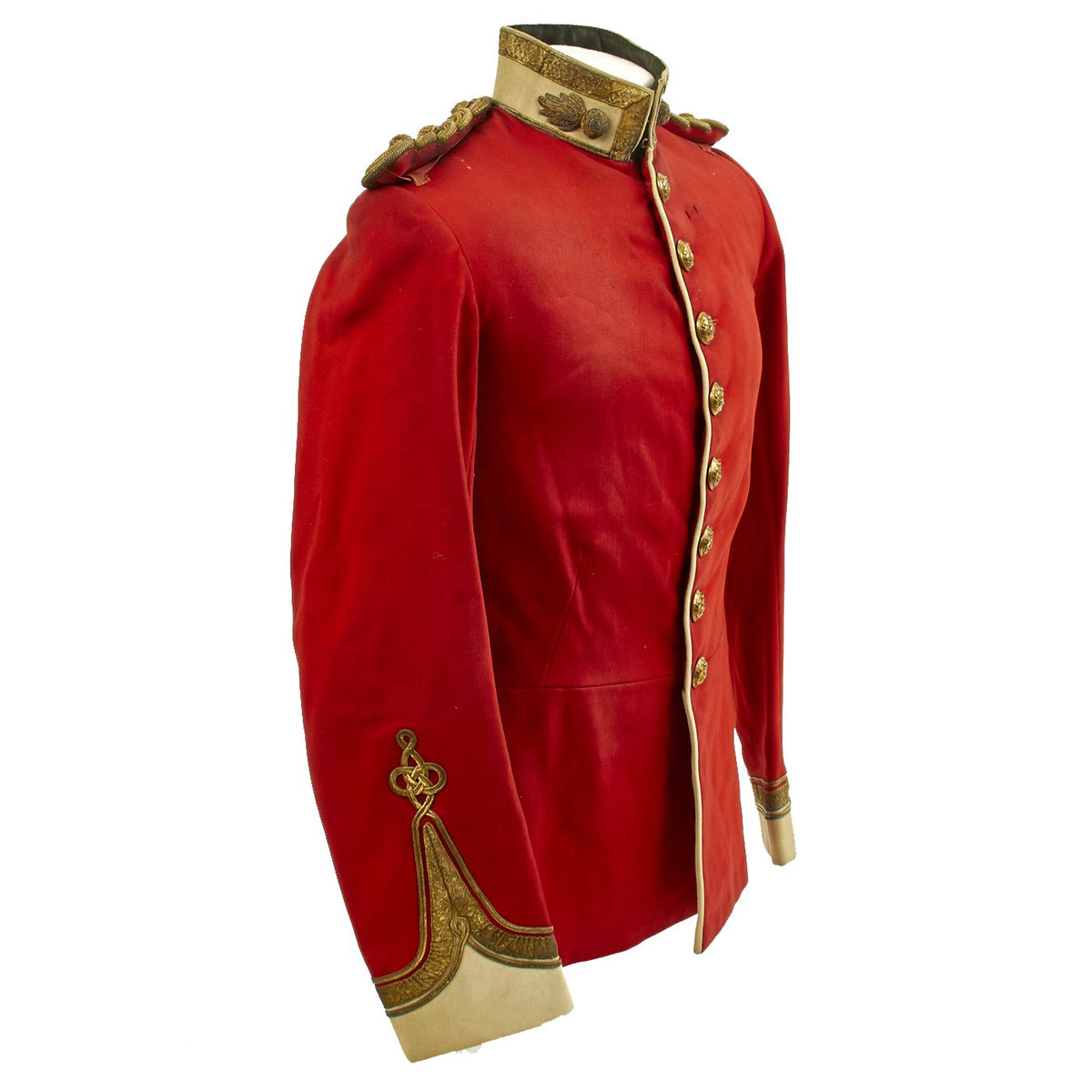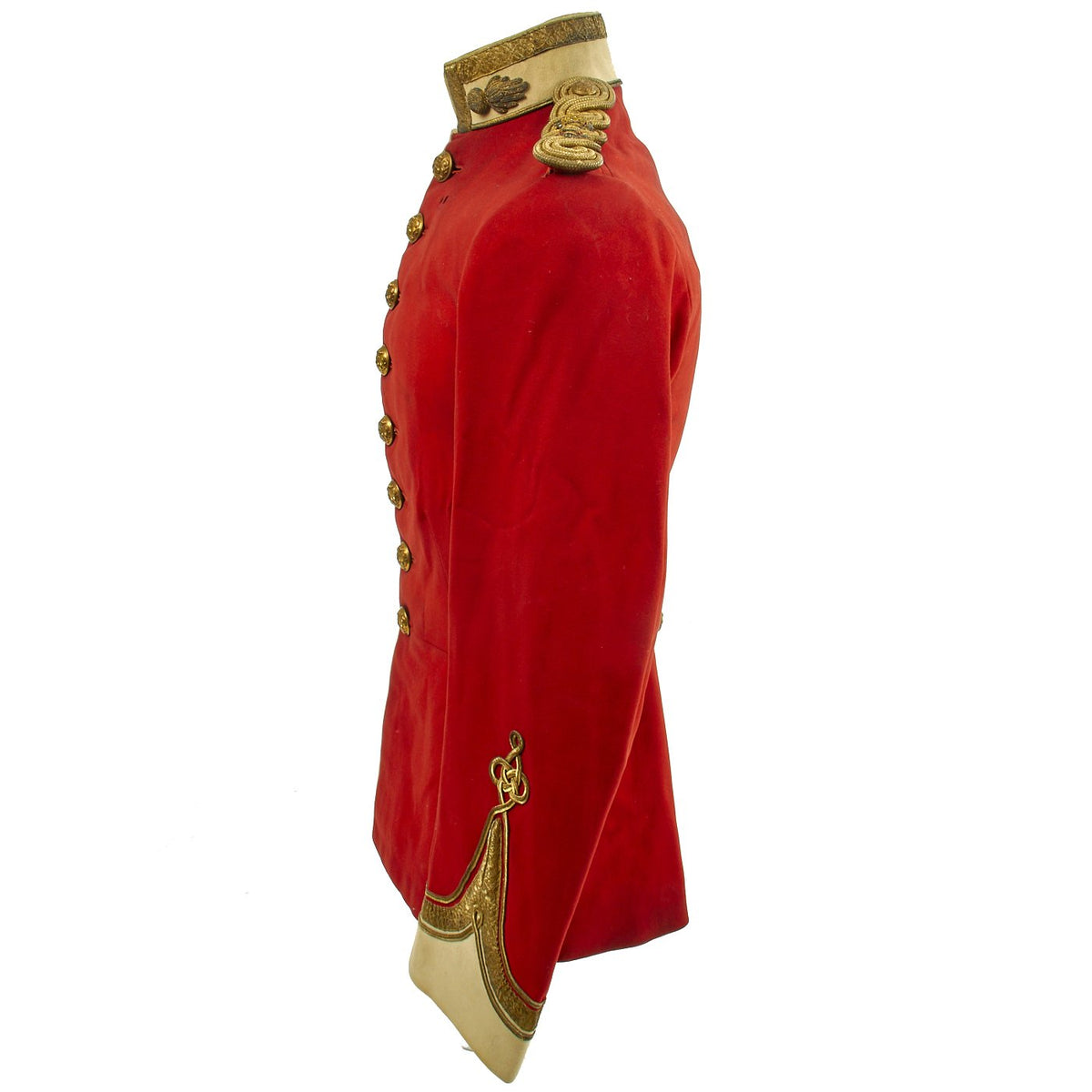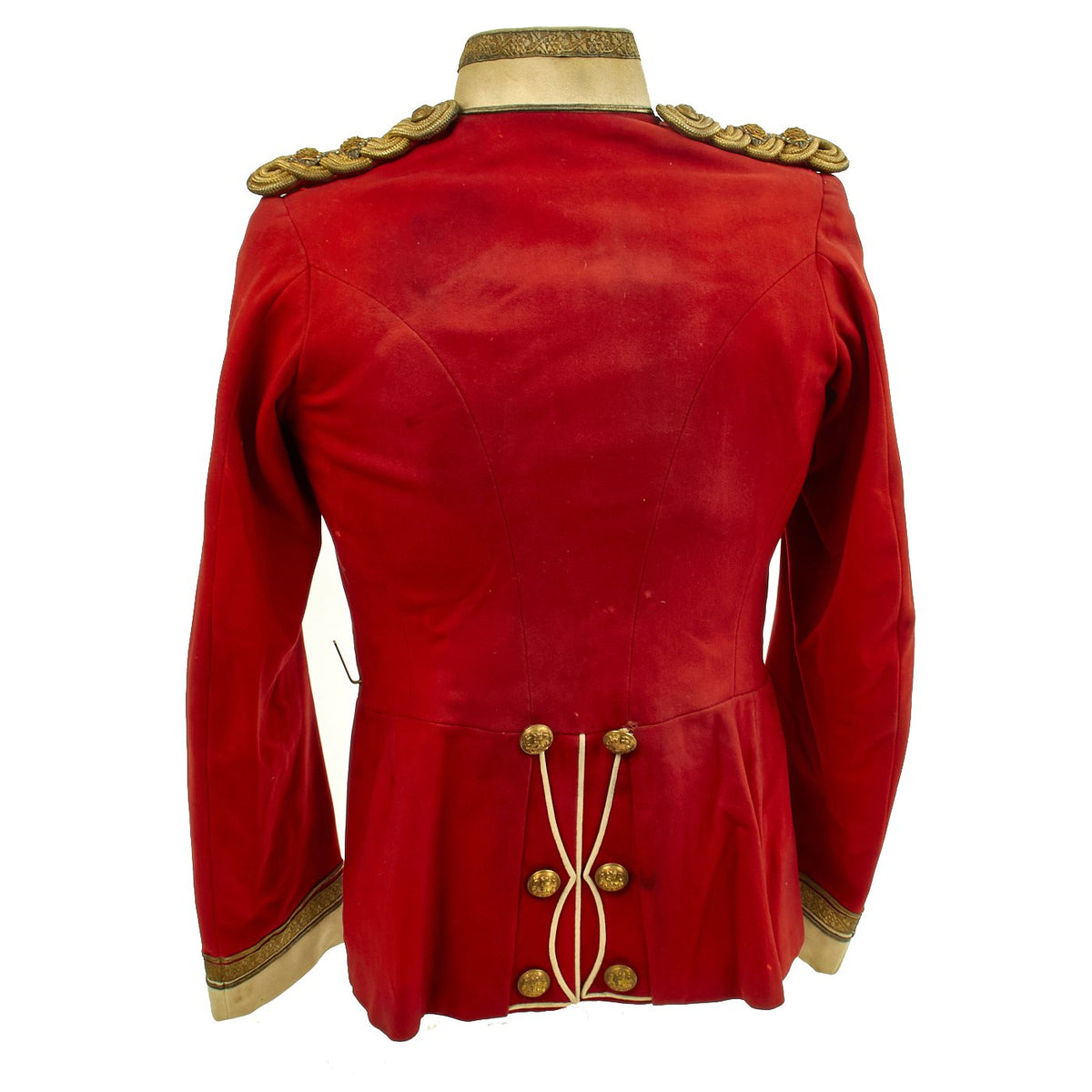Original British Victorian Lancashire Fusiliers Officer Tunic Circa 1881 – 1902 Original Items
$ 695,00 $ 208,50
Original Item: Only One Available. Dating between 1881-1902 this fine tunic is in very good condition and features original gilt Lancashire Fusiliers EGYPT Sphinx buttons with Queen’s Crown dating this tunic between 1881 – 1902. Front of tunic has 8 buttons by HAWKES & Co. , epaulets are gilt braided with two pips indicating rank of Lieutenant. Wonderfully detailed Lieutenant cuff braiding. Interior lined and shows wear.
Approximate Measurements:
Collar to shoulder: 9”
Shoulder to sleeve: 26”
Shoulder to shoulder: 15”
Chest width: 18”
Waist width: 17”
Hip width: 18”
Front length: 30″
The Lancashire Fusiliers was a line infantry regiment of the British Army that saw distinguished service through many years and wars, including the Second Boer War, the First and Second World Wars, and had many different titles throughout its 280 years of existence. In 1968 the regiment was amalgamated with the other regiments of the Fusilier Brigade–the Royal Northumberland Fusiliers, Royal Warwickshire Fusiliers and the Royal Fusiliers (City of London Regiment)–to form the current Royal Regiment of Fusiliers.
The regiment was not superficially affected by the Cardwell Reforms of the 1870s – as it already possessed two battalions, there was no need for it to amalgamate with another regiment. However, in setting its depot at Wellington Barracks in Bury from 1873, it lost its West Country affiliations. This was exacerbated by the Childers reforms of 1881. Under the reforms the regiment became The Lancashire Fusiliers on 1 July 1881. Under the new arrangements each county regiment had two Militia battalions attached to it: these were found by the 7th Royal Lancashire Militia, raised in 1855 and recruited from Bury, Manchester and Salford. This formed the 3rd and 4th Battalions of the Lancashire Fusiliers. In addition, Rifle Volunteer Corps were attached to their local regiments. In 1883 the 8th Lancashire Rifle Volunteers (raised at Bury on 22 August 1859) became the 1st Volunteer Battalion, Lancashire Fusiliers, and the 12th Lancashire Rifle Volunteers (originally the 24th, raised at Rochdale in February 1860) became the 2nd Volunteer Battalion. In 1886 the 56th Lancashire Rifle Volunteers (raised at Salford on 5 March 1860) was transferred from the Manchester Regiment to become the 3rd Volunteer Battalion.
In common with other regiments recruited from populous urban areas, the Lancashire Fusiliers raised two further regular battalions, the 3rd in 1898, and the 4th in March 1900. This necessitated adjustments to the numbers of the Militia battalions, which became the 5th and 6th battalions. However, the 3rd and 4th Regular battalions were disbanded in 1906.
The 1st Battalion was stationed in Ireland from 1881 to September 1885, and again from April 1891 to 1897. In 1899 it was posted to Crete, and from 1901 at Malta.
The 2nd Battalion was stationed in British India from 1881 to 1898, when it took part in Kitchener’s campaign to reconquer the Sudan and fought at the Battle of Omdurman. After a year at Malta, the battalion was posted to South Africa in December 1899, following the outbreak of the Second Boer War two months earlier.
During the Second Boer War, the 2nd Battalion saw action at the Battle of Spion Kop in January 1900 and took part in the Relief of Ladysmith in February 1900. The battalion served in South Africa throughout the war, which ended with the Peace of Vereeniging in June 1902. About 570 officers and men left Cape Town on the SS Britannic in October that year, and was stationed at Aldershot after their return to the United Kingdom. The 6th (Militia) Battalion also served in the war, leaving for South Africa with 650 men on 10 February 1900. All three Volunteer Battalions also found ‘service companies’ of volunteers who served alongside the Regulars, and gained the battle honour South Africa 1900–1902 for their battalions.
Fast Shipping with Professional Packaging
Thanks to our longstanding association with UPS FedEx DHL, and other major international carriers, we are able to provide a range of shipping options. Our warehouse staff is expertly trained and will wrap your products according to our exact and precise specifications. Prior to shipping, your goods will be thoroughly examined and securely secured. We ship to thousands clients each day across multiple countries. This shows how we're dedicated to be the largest retailer on the internet. Warehouses and distribution centres can be located throughout Europe as well as the USA.
Note: Orders with more than one item will be assigned a processing date depending on the item.
Before shipping before shipping, we'll conduct a thorough inspection of the items you have ordered. Today, the majority of orders will be delivered within 48 hours. The delivery time will be between 3-7 days.
Returns
The stock is dynamic and we cannot completely manage it because multiple stakeholders are involved, including our factory and warehouse. So the actual stock may alter at any time. It's possible that you may not receive your order once the order has been made.
Our policy is valid for a period of 30 days. If you don't receive the product within 30 days, we are not able to issue a refund or an exchange.
You can only return an item if it is unused and in the same state as the day you received it. You must have the item in its original packaging.
Related products
Uncategorized
Uncategorized
Uncategorized
Angolan Rebel 1970s era 60mm Inert Display Mortar from Angolan Civil War Original Items
Uncategorized
Uncategorized
Uncategorized
Uncategorized
Uncategorized
Uncategorized
Uncategorized
Uncategorized
Uncategorized
Uncategorized
Uncategorized
Uncategorized
Uncategorized
Uncategorized
Uncategorized
Band of Brothers ORIGINAL GERMAN WWII Le. F.H. 18 10.5cm ARTILLERY PIECE Original Items













































































